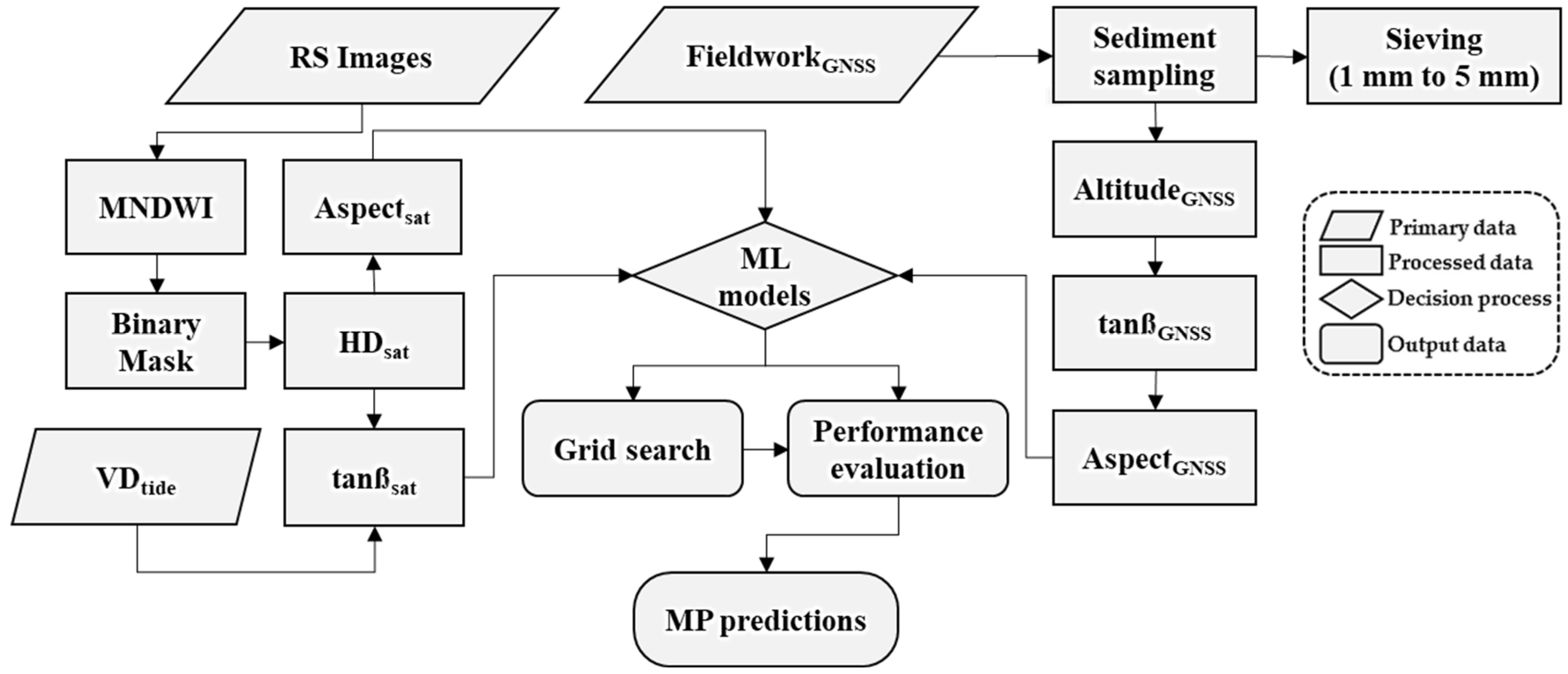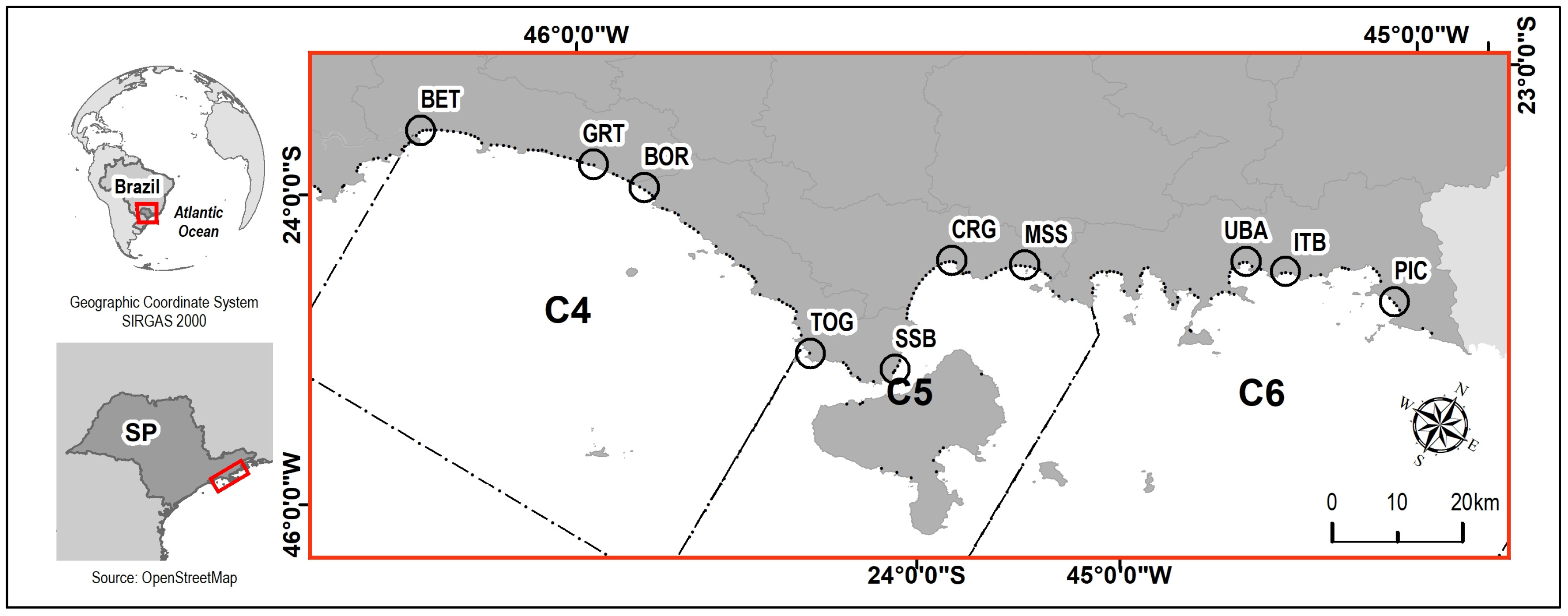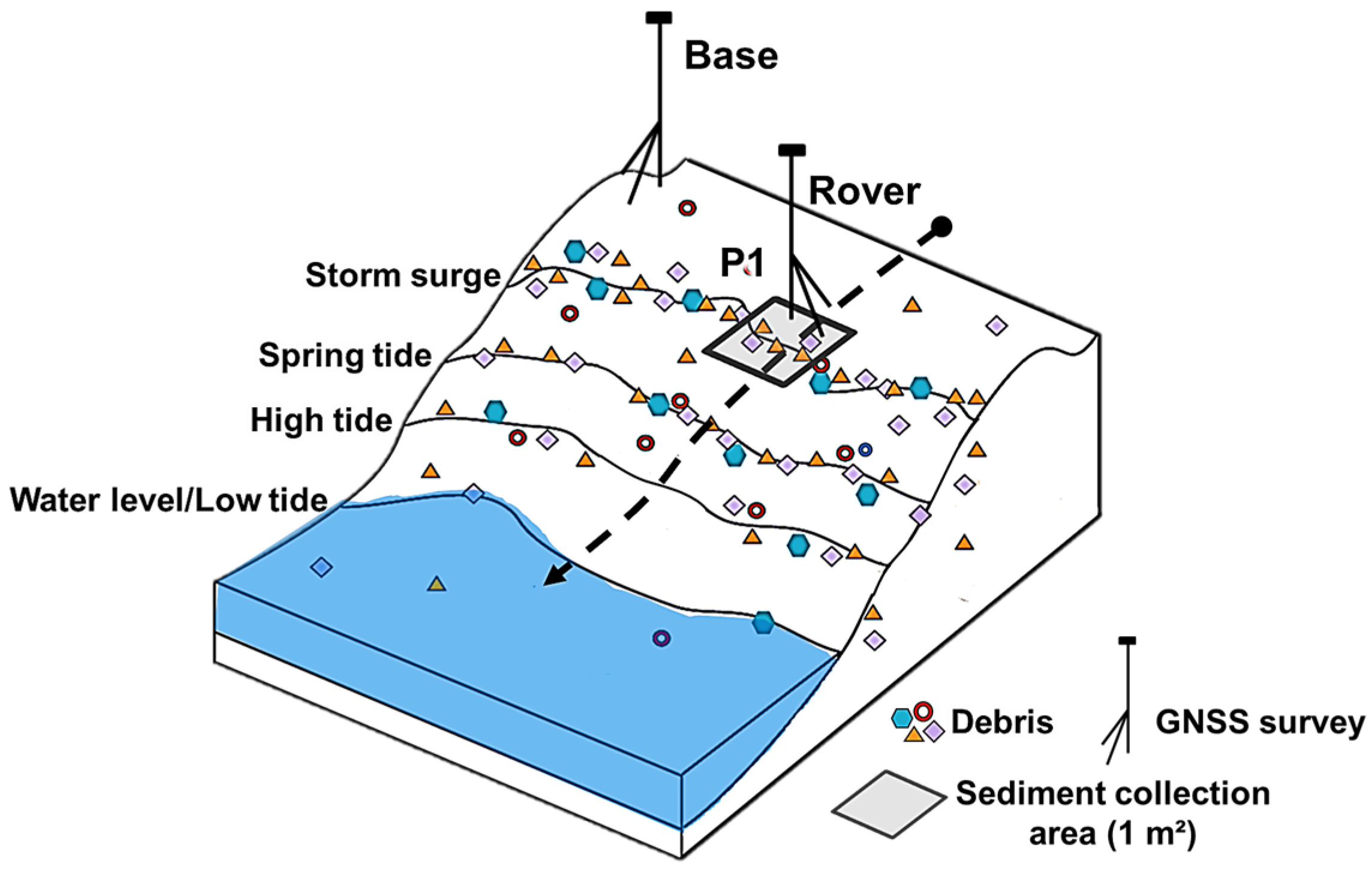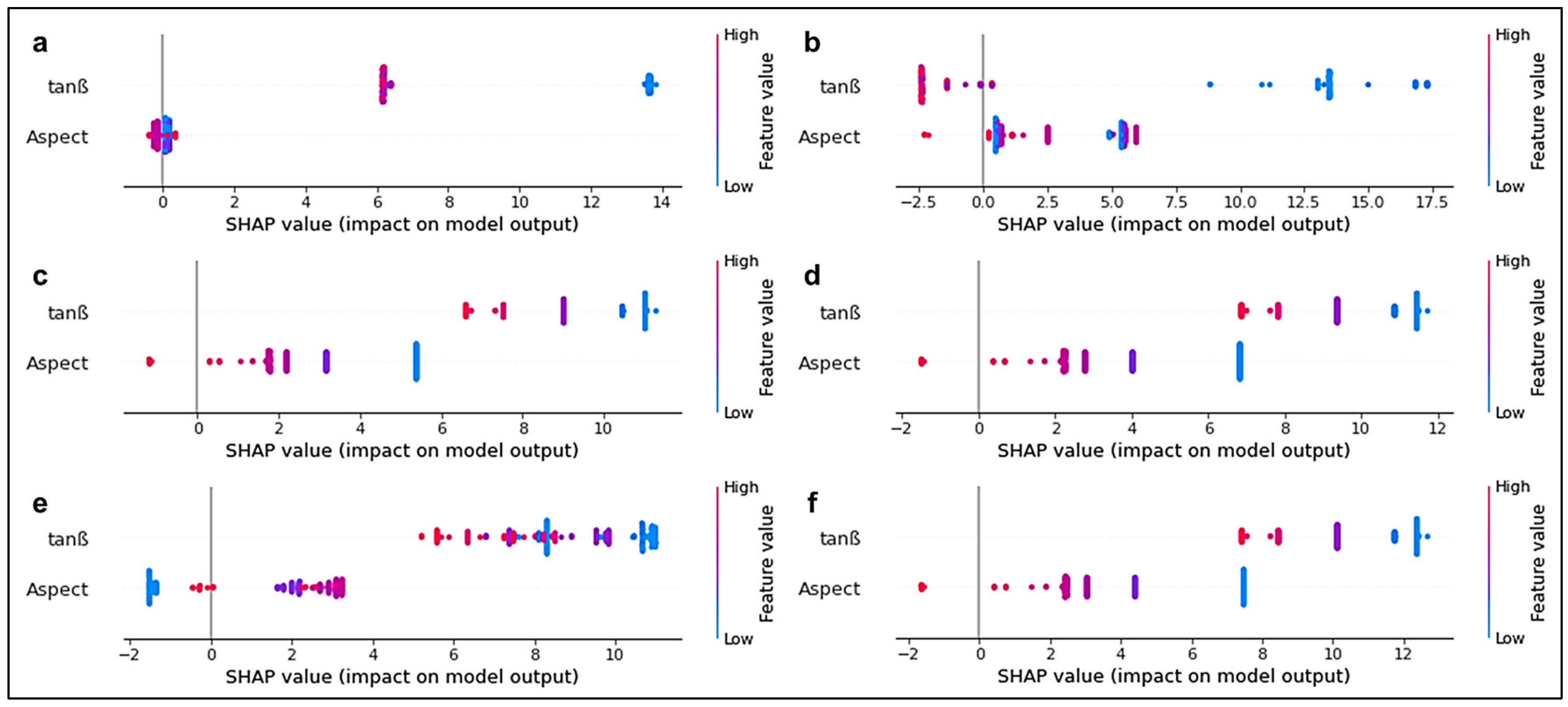Microplastic Deposit Predictions on Sandy Beaches by Geotechnologies and Machine Learning Models
Abstract
1. Introduction
2. Methodological Approach
2.1. Study Area
2.2. Orbital Remote Sensing Images
2.3. Fieldwork Samples
2.4. Machine Learning Models
3. Results
3.1. Morphometric Parameters and Microplastic Distribution In Situ
3.2. Models Calibration and Validation Metrics
3.3. Morphometric Parameters and Microplastic Distribution Models
4. Discussion
5. Conclusions
Author Contributions
Funding
Institutional Review Board Statement
Informed Consent Statement
Data Availability Statement
Acknowledgments
Conflicts of Interest
References
- Avio, C.G.; Gorbi, S.; Regoli, F. Plastics and Microplastics in the Oceans: From Emerging Pollutants to Emerged Threat. Mar. Environ. Res. 2017, 128, 2–11. [Google Scholar] [CrossRef] [PubMed]
- Ferreira, A.T.d.S.; Wetter, N.U.; Ribeiro, M.C.H.; Esteves, L.S.; Dias, A.J.G.; Grohmann, C.H.; Kuznetsova, M.; Freitas, A.Z.d.; Oliveira, R.C.d.; Siegle, E. Recognizing Microplastic Deposits on Sandy Beaches by Altimetric Positioning, μ-Raman Spectroscopy and Multivariate Statistical Models. Mar. Pollut. Bull. 2024, 209, 117025. [Google Scholar] [CrossRef] [PubMed]
- Kershaw, P.J.; Turra, A.; Galgani, F. (Eds.) GESAMP Guidelines for the Monitoring and Assessment of Plastic Litter in the Ocean; Journal Series GESAMP Reports and Studies; IMO/FAO/UNESCO-IOC/UNIDO/WMO/IAEA/UN/UNEP/UNDP/ISA Joint Group of Experts on the Scientific Aspects of Marine Environmental Prote: London, UK, 2019; 130p. [Google Scholar]
- Jambeck, J.R.; Ji, Q.; Zhang, Y.-G.; Liu, D.; Grossnickle, D.M.; Luo, Z.-X. Plastic Waste Inputs from Land into the Ocean. Science (1979) 2015, 347, 764–768. [Google Scholar] [CrossRef]
- Plastics Europe. Plastics—The Fast Facts 2023; Plastics Europe: Brussels, Belgium, 2023. [Google Scholar]
- Borriello, A. Preferences for Microplastic Marine Pollution Management Strategies: An Analysis of Barriers and Enablers for More Sustainable Choices. J. Environ. Manag. 2023, 344, 118382. [Google Scholar] [CrossRef]
- Corbau, C.; Lazarou, A.; Buoninsegni, J.; Olivo, E.; Gazale, V.; Nardin, W.; Simeoni, U.; Carboni, D. Linking Marine Litter Accumulation and Beach User Perceptions on Pocket Beaches of Northern Sardinia (Italy). Ocean Coast. Manag. 2023, 232, 106442. [Google Scholar] [CrossRef]
- Ghosh, S.; Sinha, J.K.; Ghosh, S.; Vashisth, K.; Han, S.; Bhaskar, R. Microplastics as an Emerging Threat to the Global Environment and Human Health. Sustainability 2023, 15, 10821. [Google Scholar] [CrossRef]
- Amelia, T.S.M.; Khalik, W.M.A.W.M.; Ong, M.C.; Shao, Y.T.; Pan, H.-J.; Bhubalan, K. Marine Microplastics as Vectors of Major Ocean Pollutants and Its Hazards to the Marine Ecosystem and Humans. Prog. Earth Planet. Sci. 2021, 8, 12. [Google Scholar] [CrossRef]
- Hartley, B.L.; Thompson, R.C.; Pahl, S. Marine Litter Education Boosts Children’s Understanding and Self-Reported Actions. Mar. Pollut. Bull. 2015, 90, 209–217. [Google Scholar] [CrossRef] [PubMed]
- Oliveira, J.; Belchior, A.; da Silva, V.D.; Rotter, A.; Petrovski, Ž.; Almeida, P.L.; Lourenço, N.D.; Gaudêncio, S.P. Marine Environmental Plastic Pollution: Mitigation by Microorganism Degradation and Recycling Valorization. Front. Mar. Sci. 2020, 7, 567126. [Google Scholar] [CrossRef]
- Rochman, C.M.; Hoh, E.; Kurobe, T.; Teh, S.J. Ingested Plastic Transfers Hazardous Chemicals to Fish and Induces Hepatic Stress. Sci. Rep. 2013, 3, 3263. [Google Scholar] [CrossRef]
- Teuten, E.L.; Saquing, J.M.; Knappe, D.R.U.; Barlaz, M.A.; Jonsson, S.; Björn, A.; Rowland, S.J.; Thompson, R.C.; Galloway, T.S.; Yamashita, R.; et al. Transport and Release of Chemicals from Plastics to the Environment and to Wildlife. Philos. Trans. R. Soc. B Biol. Sci. 2009, 364, 2027–2045. [Google Scholar] [CrossRef] [PubMed]
- Thompson, R.C.; Moore, C.J.; Vom Saal, F.S.; Swan, S.H. Plastics, the Environment and Human Health: Current Consensus and Future Trends. Philos. Trans. R. Soc. B Biol. Sci. 2009, 364, 2153–2166. [Google Scholar] [CrossRef]
- Fries, E.; Dekiff, J.H.; Willmeyer, J.; Nuelle, M.-T.; Ebert, M.; Remy, D. Identification of Polymer Types and Additives in Marine Microplastic Particles Using Pyrolysis-GC/MS and Scanning Electron Microscopy. Environ. Sci. Process. Impacts 2013, 15, 1949–1956. [Google Scholar] [CrossRef] [PubMed]
- Harris, P.T. The Fate of Microplastic in Marine Sedimentary Environments: A Review and Synthesis. Mar. Pollut. Bull. 2020, 158, 111398. [Google Scholar] [CrossRef]
- Royer, S.-J.; Ferrón, S.; Wilson, S.T.; Karl, D.M. Production of Methane and Ethylene from Plastic in the Environment. PLoS ONE 2018, 13, e0200574. [Google Scholar] [CrossRef] [PubMed]
- Escrobot, M.; Pagioro, T.A.; Martins, L.R.R.; de Freitas, A.M. Microplastics in Brazilian Coastal Environments: A Systematic Review. Rev. Bras. Ciências Ambient. (RBCIAMB) 2024, 59, e1719. [Google Scholar] [CrossRef]
- Ivar do Sul, J.A.; Costa, M.F. The Present and Future of Microplastic Pollution in the Marine Environment. Environ. Pollut. 2014, 185, 352–364. [Google Scholar] [CrossRef] [PubMed]
- Ferreira, A.T.d.S.; Siegle, E.; Ribeiro, M.C.H.; Santos, M.S.T.; Grohmann, C.H. The Dynamics of Plastic Pellets on Sandy Beaches: A New Methodological Approach. Mar. Environ. Res. 2021, 163, 105219. [Google Scholar] [CrossRef]
- Jong, M.-C.; Tong, X.; Li, J.; Xu, Z.; Chng, S.H.Q.; He, Y.; Gin, K.Y.-H. Microplastics in Equatorial Coasts: Pollution Hotspots and Spatiotemporal Variations Associated with Tropical Monsoons. J. Hazard. Mater. 2022, 424, 127626. [Google Scholar] [CrossRef] [PubMed]
- Ministry of Foreign Affairs of Japan. G20 Osaka Leaders’ Declaration; Osaka, Japan, 2019. Available online: https://www.mofa.go.jp/policy/economy/g20_summit/osaka19/en/documents/final_g20_osaka_leaders_declaration.html (accessed on 21 January 2025).
- United Nations. Transforming Our World: The 2030 Agenda for Sustainable Development. N.Y. United Nations Dep. Econ. Soc. Aff. 2015, 1, 41. [Google Scholar]
- UNEA. End Plastic Pollution: Towards an International Legally Binding Instrument-United Nations Environment Assembly; UNEA: Nairobi, Kenya, 2022. [Google Scholar]
- Chan, J.Y.-L.; Leow, S.M.H.; Bea, K.T.; Cheng, W.K.; Phoong, S.W.; Hong, Z.-W.; Chen, Y.-L. Mitigating the Multicollinearity Problem and Its Machine Learning Approach: A Review. Mathematics 2022, 10, 1283. [Google Scholar] [CrossRef]
- Belgiu, M.; Drăguţ, L. Random Forest in Remote Sensing: A Review of Applications and Future Directions. ISPRS J. Photogramm. Remote Sens. 2016, 114, 24–31. [Google Scholar] [CrossRef]
- Bengio, Y.; Goodfellow, I.; Courville, A. Deep Learning; MIT Press: Cambridge, MA, USA, 2017; Volume 1. [Google Scholar]
- Hastie, T.; Tibshirani, R.; Friedman, J.H.; Friedman, J.H. The Elements of Statistical Learning: Data Mining, Inference, and Prediction; Springer: Berlin/Heidelberg, Germany, 2009; Volume 2. [Google Scholar]
- Wold, S.; Ruhe, A.; Wold, H.; Dunn WJ, I. The Collinearity Problem in Linear Regression. The Partial Least Squares (PLS) Approach to Generalized Inverses. SIAM J. Sci. Stat. Comput. 1984, 5, 735–743. [Google Scholar] [CrossRef]
- Breiman, L. Random Forests. Mach. Learn. 2001, 45, 5–32. [Google Scholar] [CrossRef]
- Smola, A.J.; Schölkopf, B. A Tutorial on Support Vector Regression. Stat. Comput. 2004, 14, 199–222. [Google Scholar] [CrossRef]
- Friedman, J.H. Greedy Function Approximation: A Gradient Boosting Machine. Ann. Stat. 2001, 29, 1189–1232. [Google Scholar] [CrossRef]
- Jordan, M.I.; Mitchell, T.M. Machine Learning: Trends, Perspectives, and Prospects. Science (1979) 2015, 349, 255–260. [Google Scholar] [CrossRef]
- Lary, D.J.; Alavi, A.H.; Gandomi, A.H.; Walker, A.L. Machine Learning in Geosciences and Remote Sensing. Geosci. Front. 2016, 7, 3–10. [Google Scholar] [CrossRef]
- Ferreira, A.T.d.S.; Oliveira, R.C.d.; Ribeiro, M.C.H.; Grohmann, C.H.; Siegle, E. Coastal Dynamics Analysis Based on Orbital Remote Sensing Big Data and Multivariate Statistical Models. Coasts 2023, 3, 160–174. [Google Scholar] [CrossRef]
- Diniz, C.; Cortinhas, L.; Pinheiro, M.L.; Sadeck, L.; Fernandes Filho, A.; Baumann, L.R.F.; Adami, M.; Souza-Filho, P.W.M. A Large-Scale Deep-Learning Approach for Multi-Temporal Aqua and Salt-Culture Mapping. Remote Sens. 2021, 13, 1415. [Google Scholar] [CrossRef]
- McFeeters, S.K. The Use of the Normalized Difference Water Index (NDWI) in the Delineation of Open Water Features. Int. J. Remote Sens. 1996, 17, 1425–1432. [Google Scholar] [CrossRef]
- Xu, H. Modification of Normalised Difference Water Index (NDWI) to Enhance Open Water Features in Remotely Sensed Imagery. Int. J. Remote Sens. 2006, 27, 3025–3033. [Google Scholar] [CrossRef]
- Goya, S.C.y.; Tessler, M.G. Erosão Costeira: Exemplos No Litoral Brasileiro. In Gestão de Praias: Do Conceito à Prática; Instituto de Estudos Avançados da Universidade de São Paulo: São Paulo, Brazil, 2022; pp. 65–89. [Google Scholar]
- Tessler, M.; Goya, S.; Yoshikawa, P.H.S. Erosão e Progradação Do Litoral Brasileiro–São Paulo. In Erosão e Progradação no Litoral Brasileiro. Dieter Muehe (org.), Brasília, MMA; Muehe, D., Ed.; MMA: Brasília, Brazil, 2018; pp. 297–346. [Google Scholar]
- Campos, E.; Miller, J.; Müller, T.; Peterson, R. Physical Oceanography of the Southwest Atlantic Ocean. Oceanography 1995, 8, 87–91. [Google Scholar] [CrossRef]
- De Souza, R.B.; Robinson, I.S. Lagrangian and Satellite Observations of the Brazilian Coastal Current. Cont. Shelf Res. 2004, 24, 241–262. [Google Scholar] [CrossRef]
- Möller, O.O., Jr.; Piola, A.R.; Freitas, A.C.; Campos, E.J.D. The Effects of River Discharge and Seasonal Winds on the Shelf off Southeastern South America. Cont. Shelf Res. 2008, 28, 1607–1624. [Google Scholar] [CrossRef]
- de Castro Filho, B.M.; de Miranda, L.B.; Miyao, S.Y. Condições Hidrográficas Na Plataforma Continental Ao Largo de Ubatuba: Variações Sazonais e Em Média Escala. Bol. Inst. Oceanogr. 1987, 35, 135–151. [Google Scholar] [CrossRef]
- Andrade, T.S.d.; Sousa, P.H.G.d.O.; Siegle, E. Vulnerability to Beach Erosion Based on a Coastal Processes Approach. Appl. Geogr. 2019, 102, 12–19. [Google Scholar] [CrossRef]
- Harari, J.; De Camargo, R.; França, C.A.S.; Mesquita, A.; Picarelli, S. Numerical Modeling of the Hydrodynamics in the Coastal Area of Sao Paulo State Brazil. J. Coast. Res. 2006, 39, 1560–1563. [Google Scholar]
- Pianca, C.; Mazzini, P.L.F.; Siegle, E. Brazilian Offshore Wave Climate Based on NWW3 Reanalysis. Braz. J. Oceanogr. 2010, 58, 53–70. [Google Scholar] [CrossRef]
- Burrough, P.A.; McDonnell, R.A.; Lloyd, C.D. Principles of Geographical Information Systems; Oxford University Press: Cary, NC, USA, 2015; ISBN 0198742843. [Google Scholar]
- DHN. F-41-Descrição de Estação Maregráfica; Praticagem Santos: Santos, Brazil, 2017. [Google Scholar]
- Parreiras, T.C.; Bolfe, E.L.; Sano, E.S.; Victoria, D.d.C.; Sanches, I.D.; Vicente, L.E. Exploring the Harmonized Landsat Sentinel (Hls) Datacube to Map AN Agricultural Landscape in the Brazilian Savanna. Int. Arch. Photogramm. Remote Sens. Spat. Inf. Sci. 2022, 43, 967–973. [Google Scholar] [CrossRef]
- Flater, D. WXTide32. Available online: http://www.wxtide32.com (accessed on 21 January 2025).
- Bujan, N.; Cox, R.; Masselink, G. From Fine Sand to Boulders: Examining the Relationship between Beach-Face Slope and Sediment Size. Mar. Geol. 2019, 417, 106012. [Google Scholar] [CrossRef]
- Vos, K.; Harley, M.D.; Splinter, K.D.; Walker, A.; Turner, I.L. Beach Slopes From Satellite-Derived Shorelines. Geophys. Res. Lett. 2020, 47, e2020GL088365. [Google Scholar] [CrossRef]
- Blitzkow, D.; de Matos, A.C.O.C.; Xavier, E.M.L.; Fortes, L.P.S. MAPGEO2015: O Novo Modelo de Ondulação Geoidal Do Brasil. Rev. Bras. Cartogr. 2016, 68, 1873–1884. [Google Scholar] [CrossRef]
- Ferreira, A.T.S.; Grohmann, C.H.; Ribeiro, M.C.H.; Santos, M.S.T.; de Oliveira, R.C.; Siegle, E. Beach Surface Model Construction: A Strategy Approach with Structure from Motion-Multi-View Stereo. MethodsX 2024, 12, 102694. [Google Scholar] [CrossRef] [PubMed]
- Ferreira, A.T.S.; Amaro, V.E.; Santos, M.S.T.; Santos, A.L.S. Estimativa de Parâmetros de Ondas Oceânicas Através de Sensores Ópticos Passivos de Alta Resolução. Rev. Geol. 2012, 20–36. [Google Scholar]
- Su, J.; Zhang, F.; Yu, C.; Zhang, Y.; Wang, J.; Wang, C.; Wang, H.; Jiang, H. Machine Learning: Next Promising Trend for Microplastics Study. J. Environ. Manag. 2023, 344, 118756. [Google Scholar] [CrossRef]
- Lin, J.; Liu, H.; Zhang, J. Recent Advances in the Application of Machine Learning Methods to Improve Identification of the Microplastics in Environment. Chemosphere 2022, 307, 136092. [Google Scholar] [CrossRef]
- Chaczko, Z.; Wajs-Chaczko, P.; Tien, D.; Haidar, Y. Detection of Microplastics Using Machine Learning. In Proceedings of the 2019 International Conference on Machine Learning and Cybernetics (ICMLC), Kobe, Japan, 7–10 July 2019; IEEE: Piscataway, NJ, USA, 2019; pp. 1–8. [Google Scholar]
- Ali, J.; Khan, R.; Ahmad, N.; Maqsood, I. Random Forests and Decision Trees. Int. J. Comput. Sci. Issues (IJCSI) 2012, 9, 272. [Google Scholar]
- Bergstra, J.; Bengio, Y. Random Search for Hyper-Parameter Optimization. J. Mach. Learn. Res. 2012, 13, 285–305. [Google Scholar]
- Natekin, A.; Knoll, A. Gradient Boosting Machines, a Tutorial. Front. Neurorobot. 2013, 7, 21. [Google Scholar] [CrossRef] [PubMed]
- Ke, G.; Meng, Q.; Finley, T.; Wang, T.; Chen, W.; Ma, W.; Ye, Q.; Liu, T.-Y. Lightgbm: A Highly Efficient Gradient Boosting Decision Tree. Adv. Neural Inf. Process Syst. 2017, 30, 1–9. [Google Scholar]
- Tibshirani, R. Regression Shrinkage and Selection via the Lasso. J. R. Stat. Soc. Ser. B Stat. Methodol. 1996, 58, 267–288. [Google Scholar] [CrossRef]
- Hoerl, A.E.; Kennard, R.W. Ridge Regression: Biased Estimation for Nonorthogonal Problems. Technometrics 1970, 12, 55–67. [Google Scholar] [CrossRef]
- Tian, Y.; Shi, Y.; Liu, X. Recent Advances on Support Vector Machines Research. Technol. Econ. Dev. Econ. 2012, 18, 5–33. [Google Scholar] [CrossRef]
- Basak, D.; Pal, S.; Patranabis, D.C. Support Vector Regression. Neural Inf. Process.-Lett. Rev. 2007, 11, 203–224. [Google Scholar]
- Geladi, P.; Kowalski, B.R. Partial Least-Squares Regression: A Tutorial. Anal. Chim. Acta 1986, 185, 1–17. [Google Scholar] [CrossRef]
- Schwarz, G. Estimating the Dimension of a Model. Ann. Stat. 1978, 6, 461–464. [Google Scholar] [CrossRef]
- Fávero, L.P.; Belfiore, P. Manual de Análise de Dados: Estatística e Modelagem Multivariada Com Excel®, SPSS® e Stata®; Elsevier: Rio de Janeiro, RJ, Brazil, 2017. [Google Scholar]
- Lundberg, S. A Unified Approach to Interpreting Model Predictions. arXiv 2017, arXiv:1705.07874. [Google Scholar]
- Haberman, S.J. Analysis of Qualitative Data: Introductory Topics; Academic Press, Incorporated: New York, NY, USA, 1978. [Google Scholar]
- Johnson, R.A.; Wichern, D.W. Applied Multivariate Statistical Analysis; Pearson Education LID.: London, UK, 1992; Volume 405. [Google Scholar]
- Cutler, D.R.; Edwards, T.C., Jr.; Beard, K.H.; Cutler, A.; Hess, K.T.; Gibson, J.; Lawler, J.J. Random Forests for Classification in Ecology. Ecology 2007, 88, 2783–2792. [Google Scholar] [CrossRef]
- Eker, R.; Aydın, A. Predicting Potential Fire Severity in Türkiye’s Diverse Forested Areas: A SHAP-Integrated Random Forest Classification Approach. Stoch. Environ. Res. Risk Assess. 2024, 38, 4607–4628. [Google Scholar] [CrossRef]
- Gholami, H.; Darvishi, E.; Moradi, N.; Mohammadifar, A.; Song, Y.; Li, Y.; Niu, B.; Kaskaoutis, D.; Pradhan, B. An Interpretable (Explainable) Model Based on Machine Learning and SHAP Interpretation Technique for Mapping Wind Erosion Hazard. Environ. Sci. Pollut. Res. 2024, 31, 64628–64643. [Google Scholar] [CrossRef]
- Hu, Y.; Wu, C.; Meadows, M.E.; Feng, M. Pixel Level Spatial Variability Modeling Using SHAP Reveals the Relative Importance of Factors Influencing LST. Environ. Monit. Assess. 2023, 195, 407. [Google Scholar] [CrossRef] [PubMed]
- Souza, C.R.d.G. Praias Arenosas Oceânicas Do Estado De São Paulo (Brasil): Síntese Dos Conhecimentos Sobre Morfodinâmica, Sedimentologia, Transporte Costeiro E Erosão Costeira. Rev. Dep. Geogr. 2012, 308–371. [Google Scholar] [CrossRef]
- Kaandorp, M.L.A.; Ypma, S.L.; Boonstra, M.; Dijkstra, H.A.; van Sebille, E. Using Machine Learning and Beach Cleanup Data to Explain Litter Quantities along the Dutch North Sea Coast. Ocean Sci. 2022, 18, 269–293. [Google Scholar] [CrossRef]
- Browne, M.A.; Galloway, T.S.; Thompson, R.C. Spatial Patterns of Plastic Debris along Estuarine Shorelines. Environ. Sci. Technol. 2010, 44, 3404–3409. [Google Scholar] [CrossRef] [PubMed]
- Andrady, A.L. Microplastics in the Marine Environment. Mar. Pollut. Bull. 2011, 62, 1596–1605. [Google Scholar] [CrossRef] [PubMed]
- Barnes, D.K.A.; Galgani, F.; Thompson, R.C.; Barlaz, M. Accumulation and Fragmentation of Plastic Debris in Global Environments. Philos. Trans. R. Soc. B Biol. Sci. 2009, 364, 1985–1998. [Google Scholar] [CrossRef] [PubMed]
- Hidalgo-Ruz, V.; Thiel, M. Distribution and Abundance of Small Plastic Debris on Beaches in the SE Pacific (Chile): A Study Supported by a Citizen Science Project. Mar. Environ. Res. 2013, 87, 12–18. [Google Scholar] [CrossRef] [PubMed]
- Lebreton, L.; Andrady, A. Future Scenarios of Global Plastic Waste Generation and Disposal. Palgrave Commun. 2019, 5, 6. [Google Scholar] [CrossRef]
- Lebreton, L.C.M.; Greer, S.D.; Borrero, J.C. Numerical Modelling of Floating Debris in the World’s Oceans. Mar. Pollut. Bull. 2012, 64, 653–661. [Google Scholar] [CrossRef]
- Van Sebille, E.; Spathi, C.; Gilbert, A. The Ocean Plastic Pollution Challenge: Towards Solutions in the UK. Grant. Brief. Pap. 2016, 19, 1–16. [Google Scholar]
- Cózar, A.; Echevarría, F.; González-Gordillo, J.I.; Irigoien, X.; Úbeda, B.; Hernández-León, S.; Palma, Á.T.; Navarro, S.; García-de-Lomas, J.; Ruiz, A. Plastic Debris in the Open Ocean. Proc. Natl. Acad. Sci. USA 2014, 111, 10239–10244. [Google Scholar] [CrossRef] [PubMed]
- Young, A.; Elliott, J.A. Characterization of Microplastic and Mesoplastic Debris in Sediments from Kamilo Beach and Kahuku Beach, Hawai’i Risk of Zoonotic Disease from a Wildlife Reservoir View Project. Mar. Pollut. Bull. 2018, 113, 477–482. [Google Scholar] [CrossRef] [PubMed]
- Stein, L.P.; Siegle, E. Santos Beach Morphodynamics under High-Energy Conditions. Rev. Bras. Geomorfol. 2019, 20, 445–456. [Google Scholar] [CrossRef]
- Laurino, I.R.A.; Lima, T.P.; Turra, A. Effects of Natural and Anthropogenic Storm-Stranded Debris in Upper-Beach Arthropods: Is Wrack a Prey Hotspot for Birds? Sci. Total Environ. 2023, 857, 159468. [Google Scholar] [CrossRef]
- Stein, L.P.; Siegle, E. Overtopping Events on Seawall-Backed Beaches: Santos Bay, SP, Brazil. Reg. Stud. Mar. Sci. 2020, 40, 101492. [Google Scholar] [CrossRef]
- Lebreton, L.C.M.; Van Der Zwet, J.; Damsteeg, J.-W.; Slat, B.; Andrady, A.; Reisser, J. River Plastic Emissions to the World’s Oceans. Nat. Commun. 2017, 8, 15611. [Google Scholar] [CrossRef] [PubMed]
- Thompson, R.C.; Harrison, S.; Schmidt, C.; McCall, M. Microplastic Extraction from Sandy Beaches: Spade, Aspiration or Vacuum Cleaner? Mar. Pollut. Bull. 2021, 166, 5710. [Google Scholar]
- Gramcianinov, C.B.; Staneva, J.; de Camargo, R.; da Silva Dias, P.L. Changes in Extreme Wave Events in the Southwestern South Atlantic Ocean. Ocean Dyn. 2023, 73, 663–678. [Google Scholar] [CrossRef]
- Nunes, L.H.; Greco, R.; Marengo, J.A. Climate Change in Santos Brazil: Projections, Impacts and Adaptation Options; Springer: Berlin/Heidelberg, Germany, 2019; ISBN 9783319965352. [Google Scholar]
- Cheung, C.K.H.; Not, C. Impacts of Extreme Weather Events on Microplastic Distribution in Coastal Environments. Sci. Total Environ. 2023, 904, 166723. [Google Scholar] [CrossRef] [PubMed]
- Zamora, A.M.; da Gama, B.A.P.; de Oliveira, J.D.N.; Soares-Gomes, A. Cleaning Efficiency in a Southwestern Atlantic Sandy Beach. Reg. Stud. Mar. Sci. 2021, 45, 101865. [Google Scholar] [CrossRef]
- da Silva, M.L.; Castro, R.O.; Sales, A.S.; de Araújo, F.V. Marine Debris on Beaches of Arraial Do Cabo, RJ, Brazil: An Important Coastal Tourist Destination. Mar. Pollut. Bull. 2018, 130, 153–158. [Google Scholar] [CrossRef] [PubMed]
- da Silva, M.L.; de Araújo, F.V.; Castro, R.O.; Sales, A.S. Spatial–Temporal Analysis of Marine Debris on Beaches of Niterói, RJ, Brazil: Itaipu and Itacoatiara. Mar. Pollut. Bull. 2015, 92, 233–236. [Google Scholar] [CrossRef]
- da Silva, E.F.; do Carmo, D.d.F.; Muniz, M.C.; Dos Santos, C.A.; Cardozo, B.B.I.; de Oliveira Costa, D.M.; Dos Anjos, R.M.; Vezzone, M. Evaluation of Microplastic and Marine Debris on the Beaches of Niterói Oceanic Region, Rio De Janeiro, Brazil. Mar. Pollut. Bull. 2022, 175, 113161. [Google Scholar] [CrossRef] [PubMed]






| Compartment | Profiles ID | Sample Points |
|---|---|---|
| C4 Bertioga–Toque-Toque | BET, GRT, BOR | 3 |
| C5 Toque-Toque–Tabatinga | TOG, SSB, CRG, MSS | 4 |
| C6 Tabatinga–Picinguaba | UBA, ITB, PIC | 3 |
| Total | 10 | |
| Ranking | Qualitative Data |
|---|---|
| 0.80–1.00 | Very High (VH) |
| 0.60–0.79 | High (H) |
| 0.40–0.59 | Moderate (M) |
| 0.20–0.39 | Low (L) |
| 0.00–0.19 | Very Low (VL) |
| COD | tanβ | Aspect | Pellet | Fragment | Fiber | Foam | Film | MP/m2 |
|---|---|---|---|---|---|---|---|---|
| PIC | 0.0316 | 191 | 5 | 1 | 7 | 0 | 15 | 28 |
| ITB | 0.1242 | 138 | 0 | 0 | 4 | 0 | 4 | 8 |
| UBA | 0.1019 | 162 | 0 | 0 | 0 | 0 | 3 | 3 |
| MSS | 0.1001 | 171 | 0 | 1 | 9 | 0 | 12 | 22 |
| CRG | 0.1262 | 150 | 1 | 0 | 7 | 0 | 8 | 16 |
| SSB | 0.0950 | 119 | 1 | 0 | 4 | 0 | 8 | 13 |
| TOG | 0.1030 | 259 | 1 | 0 | 0 | 0 | 1 | 2 |
| BOR | 0.0227 | 187 | 5 | 3 | 6 | 1 | 21 | 36 |
| GRT | 0.0281 | 167 | 19 | 2 | 4 | 0 | 31 | 56 |
| BET | 0.0166 | 136 | 4 | 1 | 38 | 0 | 45 | 88 |
| Total | 36 | 8 | 79 | 1 | 148 | 272 | ||
| % | 13 | 3 | 29 | 0 | 54 | 100 | ||
| Model | R2 | MAE | RMSE | AIC | BIC | Overfit/Underfit |
|---|---|---|---|---|---|---|
| RF | 0.7283 | 5.7158 | 7.9583 | 60.8906 | 57.1423 | Good Fit |
| GB | 0.9771 | 1.3343 | 2.3081 | 52.0372 | 47.6642 | Good Fit |
| Lasso | 0.7361 | 6.6844 | 7.8436 | 44.7164 | 42.6340 | Good Fit |
| Ridge | 0.7546 | 6.6514 | 7.5641 | 40.2810 | 38.6151 | Good Fit |
| SVR | 0.7347 | 5.6361 | 7.8641 | 46.7477 | 44.4571 | Good Fit |
| PLS | 0.7836 | 6.2130 | 7.1033 | 33.5268 | 32.4856 | Good Fit |
| Var. | Compartment | N | Min | Max | Sum | Mean | SD |
|---|---|---|---|---|---|---|---|
| tanβ | C4 | 71 | 0.0309 | 0.0947 | - | 0.0578 | 0.0129 |
| C5 | 61 | 0.0309 | 0.1396 | - | 0.0719 | 0.0235 | |
| C6 | 62 | 0.0309 | 0.0951 | - | 0.0604 | 0.0107 | |
| Aspect | C4 | 71 | 108 | 184 | - | 147 | 16 |
| C5 | 61 | 108 | 184 | - | 129 | 18 | |
| C6 | 62 | 108 | 184 | - | 127 | 23 | |
| MP/m2 | C4 | 71 | 13 | 37 | 1709 | 24 | 10 |
| C5 | 61 | 13 | 37 | 1434 | 24 | 10 | |
| C6 | 62 | 13 | 37 | 1349 | 22 | 10 |
Disclaimer/Publisher’s Note: The statements, opinions and data contained in all publications are solely those of the individual author(s) and contributor(s) and not of MDPI and/or the editor(s). MDPI and/or the editor(s) disclaim responsibility for any injury to people or property resulting from any ideas, methods, instructions or products referred to in the content. |
© 2025 by the authors. Licensee MDPI, Basel, Switzerland. This article is an open access article distributed under the terms and conditions of the Creative Commons Attribution (CC BY) license (https://creativecommons.org/licenses/by/4.0/).
Share and Cite
da Silva Ferreira, A.T.; de Oliveira, R.C.; Ribeiro, M.C.H.; de Freitas Sousa, P.S.; de Paula Miranda, L.; de Oliveira Folharini, S.; Siegle, E. Microplastic Deposit Predictions on Sandy Beaches by Geotechnologies and Machine Learning Models. Coasts 2025, 5, 4. https://doi.org/10.3390/coasts5010004
da Silva Ferreira AT, de Oliveira RC, Ribeiro MCH, de Freitas Sousa PS, de Paula Miranda L, de Oliveira Folharini S, Siegle E. Microplastic Deposit Predictions on Sandy Beaches by Geotechnologies and Machine Learning Models. Coasts. 2025; 5(1):4. https://doi.org/10.3390/coasts5010004
Chicago/Turabian Styleda Silva Ferreira, Anderson Targino, Regina Célia de Oliveira, Maria Carolina Hernandez Ribeiro, Pedro Silva de Freitas Sousa, Lucas de Paula Miranda, Saulo de Oliveira Folharini, and Eduardo Siegle. 2025. "Microplastic Deposit Predictions on Sandy Beaches by Geotechnologies and Machine Learning Models" Coasts 5, no. 1: 4. https://doi.org/10.3390/coasts5010004
APA Styleda Silva Ferreira, A. T., de Oliveira, R. C., Ribeiro, M. C. H., de Freitas Sousa, P. S., de Paula Miranda, L., de Oliveira Folharini, S., & Siegle, E. (2025). Microplastic Deposit Predictions on Sandy Beaches by Geotechnologies and Machine Learning Models. Coasts, 5(1), 4. https://doi.org/10.3390/coasts5010004









